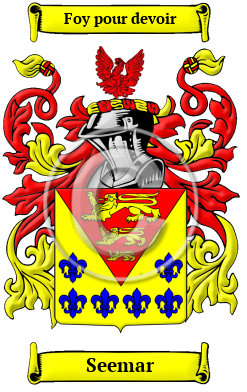| ![Show Contents]() Seemar History, Family Crest & Coats of Arms Seemar History, Family Crest & Coats of Arms
Etymology of SeemarWhat does the name Seemar mean? The history of the Seemar family name begins after the Norman Conquest of 1066. They lived in Monmouthshire. Their name, however, is a reference to St. Maur, near Avranches, Normandy. 1 "The baronial family of St. Maur, founded by the warrior of Hastings, became extinct in the chief male line at the decease in 1499 of Richard, 6th Lord St. Maur, whose only daughter and heiress, Alice, wedded William, 6th Lord Zouche of Haryngworth. The Seymours, Dukes of Somerset, whose historic greatness needs little of ancestral aid to augment its glory, claim to be a scion of the baronial house, and their pretensions may be sustained by the valuable authority of Camden." 2 Early Origins of the Seemar familyThe surname Seemar was first found in Monmouthshire. However, records differ on who was the progenitor of the family. One reference claims that Wido de St. Maur came to England in 1066 but was deceased before 1086 and would have therefore not appeared in the Domesday Book. His son William Fits-Wido held a barony in Somerset, Wiltshire and Gloucester and ten manors in Somerset. 3 "A Gilbertine priory, in honour of the Blessed Virgin Mary, was founded [in Poulton, Gloucestershire] about 1347, by Sir Thomas de Sancto Mauro, or Seymor." 4 Another reference claims they were descended from Roger Sancto Maure who lived during the reign of Henry I and was Lord of Seymour Castle. 5 Early History of the Seemar familyThis web page shows only a small excerpt of our Seemar research. Another 105 words (8 lines of text) covering the years 1299, 1458, 1474, 1509, 1528, 1536, 1537, 1547, 1549, 1563, 1593, 1599, 1613, 1632, 1646, 1648, 1663, 1674, 1708 and 1890 are included under the topic Early Seemar History in all our PDF Extended History products and printed products wherever possible. Seemar Spelling VariationsAnglo-Norman names are characterized by a multitude of spelling variations. When the Normans became the ruling people of England in the 11th century, they introduced a new language into a society where the main languages of Old and later Middle English had no definite spelling rules. These languages were more often spoken than written, so they blended freely with one another. Contributing to this mixing of tongues was the fact that medieval scribes spelled words according to sound, ensuring that a person's name would appear differently in nearly every document in which it was recorded. The name has been spelled St. Maur, Seymour, Seymer, Seymar, Seamor, Seamour, Seemour and many more. Early Notables of the Seemar familyOutstanding amongst the family at this time was John Seymor, High Sheriff of Herefordshire in 1458.Jane Seymour (1509?-1537), was "third queen of Henry VIII, was eldest of the eight children of Sir John Seymour of Wolf Hall, Savernake, Wiltshire, by Margaret, daughter of Sir John Wentworth of Nettlestead, Suffolk. Her mother's family claimed a distant relationship to the royal family." 6Sir John Seymour, of Wiltshire, KB (c.1474-1536), was English gentry, courtier to King Henry VIII, father of the king's wife Jane Seymour; Edward Seymour...
Another 83 words (6 lines of text) are included under the topic Early Seemar Notables in all our PDF Extended History products and printed products wherever possible. Migration of the Seemar family to IrelandSome of the Seemar family moved to Ireland, but this topic is not covered in this excerpt.
Another 64 words (5 lines of text) about their life in Ireland is included in all our PDF Extended History products and printed products wherever possible. Migration of the Seemar familyFor many English families, the political and religious disarray that plagued their homeland made the frontiers of the New World an attractive prospect. Thousands migrated, aboard cramped disease-ridden ships. They arrived sick, poor, and hungry, but were welcomed in many cases with far greater opportunity than at home in England. Many of these hardy settlers went on to make important contributions to the emerging nations in which they landed. Among early immigrants bearing the name Seemar or a variant listed above were: William Seymour who settled in Virginia in 1653; George Seymour settled in Barbados in 1679; William Seymour settled in Maryland in 1725; John Seymer was banished to Barbados in 1685.
The motto was originally a war cry or slogan. Mottoes first began to be shown with arms in the 14th and 15th centuries, but were not in general use until the 17th century. Thus the oldest coats of arms generally do not include a motto. Mottoes seldom form part of the grant of arms: Under most heraldic authorities, a motto is an optional component of the coat of arms, and can be added to or changed at will; many families have chosen not to display a motto.
Motto: Foy pour devoir
Motto Translation: Faith for duty.
- Cleveland, Dutchess of The Battle Abbey Roll with some Account of the Norman Lineages. London: John Murray, Abermarle Street, 1889. Print. Volume 3 of 3
- Burke, John Bernard, The Roll of Battle Abbey. London: Edward Churton, 26, Holles Street, 1848, Print.
- The Norman People and Their Existing Descendants in the British Dominions and the United States Of America. Baltimore: Genealogical Publishing, 1975. Print. (ISBN 0-8063-0636-X)
- Lewis, Samuel, A Topographical Dictionary of England. Institute of Historical Research, 1848, Print.
- Lower, Mark Anthony, Patronymica Britannica, A Dictionary of Family Names of the United Kingdom. London: John Russel Smith, 1860. Print.
- Smith, George (ed), Dictionary of National Biography. London: Smith, Elder & Co., 1885-1900. Print
 |

